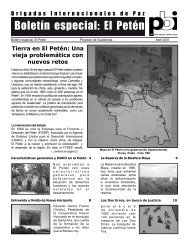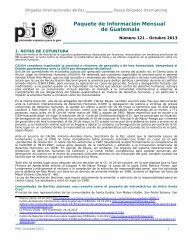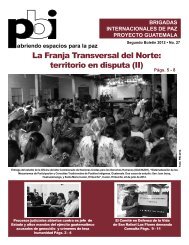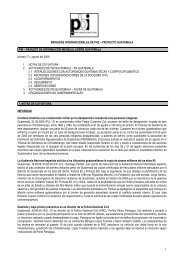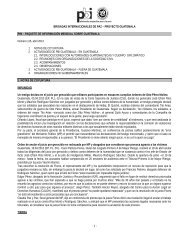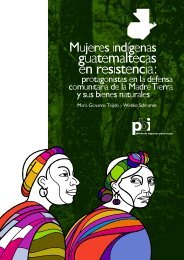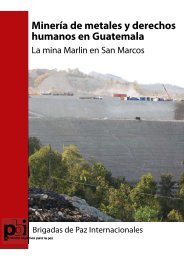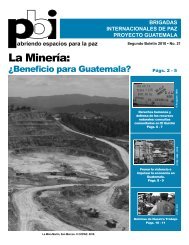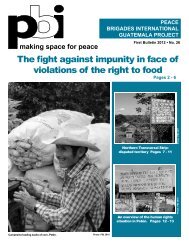The Northern Transversal Strip disputed territory (II) Photo
Bulletin 27 - 2nd of 2012 (pdf 1.4 MB) - PBI
Bulletin 27 - 2nd of 2012 (pdf 1.4 MB) - PBI
Create successful ePaper yourself
Turn your PDF publications into a flip-book with our unique Google optimized e-Paper software.
PEACE BRIGADES INTERNATIONAL<br />
Brigadas Internacionales de Paz<br />
Legal proceedings open against former Head<br />
of State and high-ranking officers of the<br />
Guatemalan army accused of genocide and<br />
crimes against humanity<br />
Two former high-ranking officers of the Guatemalan army and a<br />
former Head of State stand before the Guatemalan justice system<br />
accused of the genocide of the Mayan Ixil people and of crimes<br />
against humanity.<br />
On 17 June 2011 the National Civilian Police (PNC) detained<br />
the retired general Héctor Mario López Fuentes, Chief of Defence<br />
during the de facto government of General José Efraín Ríos Montt<br />
(March ‘82 - August ‘83), accusing him of genocide and crimes<br />
against humanity. <strong>The</strong>se acts, committed 29 years ago, were first<br />
brought before the Guatemalan criminal justice system in 2000.<br />
This was the first arrest in Guatemala on a charge of genocide<br />
and marked the start of a series of arrests of high-ranking officers,<br />
including Efraín Ríos Montt, who was Head of State during the<br />
most violent period of internal armed conflict in the country. 1 Legal<br />
proceedings linked to these arrests have recently commenced<br />
and in January 2012 the genocide trial against Ríos Montt opened<br />
before the High Risk Court in Guatemala City. This was a historic<br />
act in Guatemala; a former Head of State had never before faced<br />
trial. Since the Guatemalan judicial system began processing<br />
genocide cases in mid2011, the national press has written a great<br />
deal about what the term means. This article presents the definition<br />
of genocide according to international law, a definition which, after<br />
the State ratified the relevant treaties, is now part of Guatemala’s<br />
legal framework. 2 <strong>The</strong> article later accounts for some of the events<br />
which took place during the internal armed conflict, in order to shed<br />
light on current legal proceedings.<br />
Genocide, as defined by international law<br />
Shortly before the end of the Second World War, in which millions<br />
of people were killed, the General Assembly (GA) of the United<br />
Nations (UN) declared for the first time that genocide contravened<br />
international law and that punishment for the crime was a matter of<br />
international concern. Genocide was considered “a denial of entire<br />
human groups’ right to exist… which upsets the human conscience<br />
and causes great losses for humanity… it contradicts moral and<br />
spiritual law and the objectives of the United Nations”. <strong>The</strong> resolution<br />
entrusted the UN’s Economic and Social Council (ESOSOC) to<br />
develop the draft for a genocide convention. <strong>The</strong> Convention on<br />
the Prevention and Punishment of the Crime of Genocide was<br />
approved by the General Assembly in December 1948, and was the<br />
first human rights treaty adopted by the UN. 3 Through its ratification<br />
many states (including Guatemala) recognised this definition 4 , which<br />
was confirmed in the Statutes of the Special Tribunals for the former<br />
Yugoslavia 5 , Rwanda 6 , and the Rome Statute of the International<br />
Criminal Court in 1998. <strong>The</strong> convention defined genocide as follows:<br />
‘Genocide’ is understood as any of the acts listed below,<br />
perpetrated with the intention of destroying, totally or partially, a<br />
national, ethnic, racial or religious group by means of:<br />
a) Killing members of the group;<br />
b) Causing serious bodily or mental harm to members of the<br />
group;<br />
c) Deliberately inflicting on the group conditions of life calculated<br />
to bring about its physical destruction, in whole or in part;<br />
d) Imposing measures intended to prevent births within the<br />
group;<br />
e) Forcibly transferring children of the group to another group. 7<br />
Genocide, as defined by the Convention, contains a subjective<br />
element which distinguishes it from other crimes against humanity;<br />
the intention (mens rea) to totally or partially destroy a protected<br />
group, by committing one or more of the acts in the Convention’s<br />
definition. 8 <strong>The</strong> UN Commission for Historical Clarification (CEH)<br />
pointed out that intent differs from motive in killings or other acts<br />
as detailed above.“ <strong>The</strong> intent to destroy a group is sufficient for<br />
a crime to qualify as genocide, whatever the motive may be. For<br />
example, if the motive to destroy an ethnic group is not racist by<br />
1 In the report “Memory of Silence”, Commission for Historical Clarification (CEH) states that 48% of all registered cases of violent acts occurred in 1982, CEH, Guatemala, Memory of Silence,<br />
Volume ll, Guatemala, 1998.<br />
2 Following its ratification of the Convention, the Guatemalan State must now adapt its legal framework. Furthermore Article 46 of the Guatemalan Constitution recognises the pre-eminence<br />
of international treaties ratified by Guatemala on human rights issues. “Article 46 - Pre-eminence of International Law. <strong>The</strong> general principle is now established that with regard to human<br />
rights matters, the treaties and conventions accepted and ratified by the Guatemalan State take precedent over domestic law.”<br />
3 Schabas, William A: Convention on the Prevention and Punishment of the Crime of Genocide in: http.//untreaty.un.org/cod/avl/ha/cppcg/cppcg.html<br />
4 <strong>The</strong> Convention on the Prevention and Punishment of the Crime of Genocide was ratified by Guatemala (in 1950) and has today been ratified by 141 other countries. For up-to-date information<br />
see: http://untreaty.un.org/cod/avl/ha/cppcg.html<br />
5 Statute of the International Criminal Tribunal for the former Yugoslavia, 25 May 1993, Article lV.<br />
6 Statute of the International Criminal Tribunal for Rwanda, 8 November 1994, Article ll.<br />
7 Rome Statute of the International Criminal Court, 17 July 1998, Article Vl and Convention for the Prevention and Punishment of the Crime of Genocide, 9 December 1948, Article ll.<br />
8 International Review of the Red Cross, Volume 91 Number 876, December 2009, Kai Ambos: “What does ‘intent to destroy’ in genocide mean?”<br />
2 Second Bulletin 2012 • No. 27



